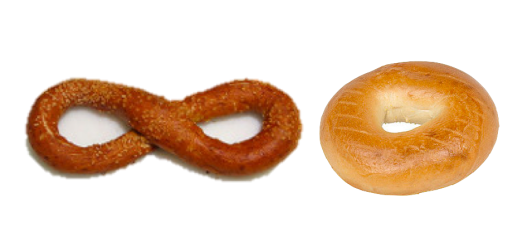Every year the Nobel Prizes bring some extra attention to science in the award categories of medicine, physics, and chemistry. This is a great opportunity for the general public to hear about science, but it can pose some communication challenges. How do you explain, for example, “theoretical discoveries of topological phase transitions and topological phases of matter,” the topic of this year’s physics prize, in a two-minute radio piece (or a blog post)? This year, the answer to that question involves food!

For the Physics Prize, awarded half to David Thouless (University of Washington, USA) and half to F. Duncan Haldane (Princeton University, USA) and J. Michael Kosterlitz (Brown University, USA), foods were used in a presentation to explain how the field of topology “describes properties that are stable and only change in integer steps: 1, 2, 3…”1 This may sound obscure, but it’s easy to understand in terms of pastries: a pretzel like the one shown above has two holes in it, a bagel has one hole, and a cinnamon roll has zero holes. There’s no such thing as a bagel with half a hole, or a pretzel with 2.5 holes — the holes only exist as integers.

You can watch the entire Nobel presentation about the physics prize in the video below, which is cued up to the pertinent section:
This year’s Chemistry Nobel was awarded to Jean-Pierre Sauvage (University of Strasbourg, France), Sir J. Fraser Stoddart (Northwestern University, USA), and Bernard L. Feringa (University of Groningen, the Netherlands) “for the design and synthesis of molecular machines.” Since these machines are at the nano scale (or even smaller!), this prize relates more closely than the physics prize to the work of the Center for Sustainable Nanotechnology, but it does not lend itself as easily to food analogies. However, there is other good imagery to help us understand some basics about how molecular machines work. The New York Times compares one of Sauvage’s early discoveries to chain links (like the image below), and one of Stoddart’s developments to a ring around a dumbell or a bead on an abacus.2

All of these different nano-scale shapes are important because they are some of the building blocks for the molecular machines that are being recognized by the Nobel Prize. These machines include switches, pumps, motors, and even a nanocar,3 all operating on an unfathomably tiny scale.
This is probably only the beginning of what we’ll be hearing about molecular machines, as new technologies start to be developed based on this science. As those new technologies emerge, scientists and reporters will come up with new ways to explain how they work, which may or may not include any baked goods… I’m sure someone has made doughnuts or bread in the shape of interlocking rings like the catenane molecule, but alas, I couldn’t find any pictures. If you feel inspired to do some chemistry-inspired baking, send us a photo!
P.S. In case you missed it, our last blog post dealt more seriously with the challenges of doing nuanced and accurate science communication. There’s also a lot more to say about the Nobels, of course, and no discussion of the pros and cons of science publicity from the Prizes would be complete without pointing out their glaring lack of diversity. For an introduction to this topic, the Telegraph did an analysis around geography and gender in 2014 that you can read here.
EDUCATIONAL RESOURCES
- The Guardian: Teaching the Nobel prize: news and resources round up (from 2012 but lots of resources are still relevant)
- Nobel Prize: Educational – games & simulations related to prize-awarded achievements
REFERENCES
- Pollard, N. & Hirschler, B. Bagel, pretzel show twists of Nobel Prize-winning work in physics. Reuters, Oct 4, 2016. Retrieved from http://www.reuters.com/article/us-nobel-prize-physics-idUSKCN1240VO.
- Chang, K. & Chan, S. 3 Makers of World’s Smallest Machines Awarded Nobel Prize in Chemistry. New York Times, Oct 5, 2016. Retrieved from http://www.nytimes.com/2016/10/06/science/nobel-prize-chemistry.html
- Peplow, M. The tiniest Lego: a tale of nanoscale motors, rotors, switches and pumps. Nature, 525, 18–21. doi: 10.1038/525018a
Special thanks to Miranda Gallagher for suggesting this post.

[…] Nobel Prize in Chemistry: press release and Sustainable Nano blog post […]